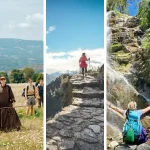What I Learned Exploring the White Cliffs of Dover Alone in Spring

The train doors slid open at Dover Priory Station, and for a moment, I hesitated before stepping out. It wasn’t nerves — I’ve traveled alone through far more chaotic places — but Dover felt different for White Cliffs of Dover. Quieter. More layered. And in early spring, still wearing a veil of cold air and silence that I hadn’t quite expected.
I’d left St. Pancras just after sunrise, chasing a curiosity that had lingered since my university days when I first read about the White Cliffs in a battered copy of Matthew Arnold’s poems.
This wasn’t a spontaneous day trip. I’d timed it, planned it, even waited for the shoulder season — March, when the crowds are still weeks away and the cliffs are more likely to speak plainly.
A short walk from the station led me through a town waking up slowly. Locals moved without rush. A chalkboard outside a bakery advertised hot pasties and lemon sponge. Just past the Duke of York’s Roundabout, I caught the first smell of sea air. Not the tropical kind that hits you with salt and warmth — this was colder, crisper, almost metallic.
At the National Trust Visitor Centre, I grabbed a fold-out trail map and chatted briefly with an older volunteer. “Heading up to the lighthouse?” he asked, glancing at the boots I’d worn down in Patagonia. I nodded. “You’ve picked the right day. No wind yet,” he said, half-smiling like someone who’d seen more hikers misjudge that trail than he could count.
By the time I reached the cliff-top path, the town was behind me, and only the wind — beginning to stretch its limbs — kept me company. Orchids pushed through the chalky grass, and the sea far below moved like breath. Across the water, the French coast shimmered faintly. It didn’t feel dramatic. It felt precise, quiet, historic in a way that doesn’t need to declare itself.
And so began my solo walk across the White Cliffs of Dover — not chasing drama, not fleeing anything. Just walking. Paying attention.
I. Why the White Cliffs of Dover Called Me

I didn’t decide to visit the White Cliffs of Dover on a whim. This was a pull that had been building for years — layered through books, films, quiet conversations with British friends, and long evenings paging through old travel journals I’d written during colder seasons across England.
The cliffs always stood out as more than just a pretty view. They felt symbolic… especially for someone traveling solo.
What first sparked it? Maybe it was Dame Vera Lynn’s voice echoing through a WWII exhibit I saw in Portsmouth years ago, singing “There’ll be bluebirds over…” Or maybe it was from reading about Operation Dynamo — the desperate evacuation of Dunkirk — where these cliffs stood as the last landmark seen by thousands of returning soldiers.
But if I’m honest, what really prompted the journey was a stretch of quiet. A few weeks without motion. I’d been in London for a project and needed a reason to leave the noise. To find space again. And spring — early spring — felt like the right time to do it. Not yet crowded. Not yet blooming in full. The kind of season where solitude doesn’t feel forced… it just fits.
The cliffs in springtime offer a kind of rawness that isn’t always in the travel brochures. You get mist more than sunlight. The air smells of wet stone and seaweed, not wildflowers. But in that simplicity, I found exactly what I’d hoped for — a quietness that echoed back everything I’d been carrying for weeks.
During the walk, the cliffs didn’t feel grand or heroic. They felt honest. Worn. Alive. I remember tracing my hand along the chalky edge of a stone wall near Langdon Bay, thinking about all the eyes that had stared across this channel over the centuries — Roman invaders, wartime pilots, homesick sailors.
That sense of place, layered with meaning, is why I came. I didn’t just want to see the White Cliffs. I wanted to walk through the history… and feel what so many before me must have felt.
II. Getting There from London – A Solo Traveler’s Guide

Getting from London to the White Cliffs of Dover is surprisingly straightforward — and a journey I’ve made in more than one way.
Whether you’re planning a quick day trip to Dover from London or looking to wander at a slower pace, your route sets the tone for the whole experience.
I’ve tried both the train and the bus, and each has its trade-offs depending on your travel style and timing.
London to White Cliffs of Dover by Train

The train is by far the fastest and most scenic route. I boarded an early morning service from London St. Pancras International, and just over an hour later, I stepped onto the quiet platform at Dover Priory Station — a great option for solo travelers like me who value flexibility and don’t want to spend hours in transit.
Booking in advance through National Rail or using an Oyster card-compatible app helped me grab an off-peak fare for around £20–£25.
I always recommend aiming for the 8:00–8:30 a.m. departure, especially in spring. The air is still crisp, and if you’re lucky, the coastal mist will start lifting just as you arrive.
From Dover Priory, it’s a 25–30 minute walk to the cliff-top path near the National Trust Welcome Centre — or you can take a quick local bus or taxi if you’re not up for walking right away. I’ll cover this in more detail in the next section.
✔️ London to White Cliffs of Dover by Bus

If you’re budget-conscious or not in a rush, the London to White Cliffs of Dover bus via National Express can be a relaxed alternative. The ride takes about 2.5 to 3 hours, and while it lacks the scenic speed of the train, you’ll pass through some of Kent’s countryside and smaller towns. Tickets can be as low as £10–£15 if booked ahead.
I once took this route on a rainy Thursday just to observe the contrast. It was less efficient but felt oddly more local — watching schoolchildren hop on, hearing casual conversations about the Port of Dover, and seeing how life moves beyond the postcard version of the Cliffs of Dover.
✔️ Timing Tips for Solo Travelers
If you’re traveling alone, timing is your ally. Arriving by 9:30 or 10:00 a.m. puts you ahead of most tour groups, giving you the freedom to walk the cliffs in near solitude. I always carry a light thermos, a scarf, and a portable phone charger — spring weather along the Strait of Dover can shift fast, and phone signal does drop near some viewpoints.
On one visit, I arrived just after 11 a.m. and found the main trail already dotted with school groups and coach tours. That day, I ended up detouring toward Langdon Hole, a lesser-walked patch that gave me a moment of peace overlooking the English Channel.
✔️ Logistics Recap: Train vs. Bus
| Route | Duration | Cost (avg.) | Pros | Cons |
|---|---|---|---|---|
| Train (St. Pancras → Dover Priory) | ~1h 10m | £20–£30 | Fast, scenic, frequent departures | Slightly more expensive |
| Bus (Victoria Coach Station → Dover) | ~2.5–3h | £10–£20 | Cheaper, relaxed | Slower, limited views |
Final Thought on Getting There
Whether you choose train or bus, how to get to the White Cliffs of Dover from London really depends on what you want from the journey.
For me, the train offers momentum and energy, while the bus lets the landscape unfold slowly. Either way, both bring you to one of Britain’s most iconic natural landmarks — and the journey itself is part of the story.
III. First Impressions & Route Selection from Dover Priory Station
The moment you step out of Dover Priory Station, things slow down. It’s not a grand arrival — no busy plazas or tour buses waiting outside — but that’s honestly part of the charm. As a solo traveler, I appreciated how quiet and walkable it felt. You can hear the gulls overhead, catch a glimpse of Dover Castle up the hill, and almost smell the sea in the distance.
Now, this is where many first-timers pause and think… “Do I really walk all the way to the cliffs from here?” And the answer is yes — if you can. The walk from Dover Priory to the White Cliffs takes about 25–30 minutes, and it’s part of the experience. But there are a few ways to go about it, depending on your energy level and how you like to explore.
✔️ Walking Route to the White Cliffs of Dover

This is my go-to, and what I’d suggest if the weather is clear and you’re feeling up for it. Head down Folkestone Road, follow the signs toward the National Trust White Cliffs Visitor Centre, and enjoy the gradual shift from urban to rural. I usually stop for a takeaway coffee near Biggin Street — local cafés there are cheap and way better than chain options.
About halfway through, you’ll start seeing chalky hillsides, and the sea horizon opens up like a postcard. For solo travelers looking to soak in the first views of the White Cliffs, this gradual reveal is unforgettable.
Make sure you wear proper shoes though — I’ve made the mistake of going in sneakers after rain, and the trail to the cliff paths can get slick.
✔️ Taking a Taxi or Bus (If You’re Short on Time)
If walking isn’t your thing — or if you’re pressed for time — taxis are usually parked outside Dover Priory or just a short call away. A quick ride to the White Cliffs Visitor Centre will cost you about £7–£10.
There are also local buses (like the 60 or 15) that can get you within walking distance of the cliffs, especially on weekdays. But I’ll be real — the schedule can be a bit unpredictable if you’re not used to small-town UK transit. Always check live departures using the Stagecoach app or Google Maps.
✔️ Solo Traveler Tip: Go Early or Late

The best way to enjoy the cliffs without a crowd? Aim for early morning or golden hour. On my most recent visit, I arrived at the Visitor Centre by 9:45 a.m., and the trail was nearly empty. By noon, it was packed. Alternatively, if you’re staying overnight, try walking back up near sunset — it’s when the cliffs actually start glowing.
There’s a kind of stillness in those hours that solo travelers often crave. It’s quiet enough to hear the wind in the grass and the crash of waves below. Plus, fewer people mean better photos.
IV. Best Walking Routes & Photo Spots Along the White Cliffs

Once you’re on the trail, the White Cliffs of Dover walking route starts to unfold in the most cinematic way. And if you’re doing this solo, it almost feels like the land is telling you where to go — no rush, no strict path, just nature pulling you forward with one incredible view after another.
✔️ The Classic National Trust Trail (Visitor Centre to South Foreland Lighthouse)

This is the most popular and well-maintained route, and for good reason. It starts at the White Cliffs Visitor Centre and winds its way along the coastline all the way to the South Foreland Lighthouse, which sits about 2 miles away.
The path is relatively easy for most walkers, with a few gentle inclines. You don’t need to be an experienced hiker — just wear decent shoes and maybe pack a windbreaker. Trust me, the breeze can go from refreshing to aggressive real quick.
Along this stretch, you’ll hit several of the best photography spots along the White Cliffs of Dover. About 15 minutes in, there’s a quiet overlook where the chalk cliffs drop dramatically into the Channel, and if the sky’s clear, you can even see the coast of France shimmering in the distance. I stood there for a while, no headphones, just breathing. It was kind of perfect.
If you’re into travel photography, bring a lens with some zoom — the combination of grassland, sea, and sheer cliffs makes for some striking compositions. And if you’re just using your phone, a little editing later can make your shots pop without filters.
✔️ Fan Bay Deep Shelter: A Worthy Detour
Roughly halfway to the lighthouse, you’ll see a sign pointing toward Fan Bay Deep Shelter. This isn’t just another viewpoint — it’s a hidden underground military tunnel complex dating back to WWII.
The entrance is subtle (I nearly missed it the first time), but the site offers tours where you can explore these eerie, echo-filled shelters carved into the chalk. If you’re a history buff or just love unusual things to do in Dover, it’s 100% worth the £10 or so. And yes, they take card.
One note: they only allow small groups in at a time, so booking ahead or arriving early helps.
✔️ South Foreland Lighthouse: A Calm Ending
The trail ends at the South Foreland Lighthouse, a peaceful, grassy area perfect for sitting down and letting your legs rest. There’s a small tea room here too — very English, very cozy — and if the weather’s behaving, you can sit outside with a scone and just… stare at the sea.
If you’re traveling solo, this spot feels especially rewarding. You’re not just sightseeing — you’ve earned this pause. This whole route, from the White Cliffs Visitor Centre to South Foreland Lighthouse, is one of the most scenic solo walks in southern England, and honestly, a great reset from the usual noise of travel.
✔️ Quick Tips for Best Photo Ops
- Morning light brings soft shadows and deep contrasts — ideal for cliff edge photos.
- The golden hour right before sunset gives the cliffs a warm glow.
- For that classic cliff-side shot, look for grassy ledges just off the main trail — but stay safe and away from the fragile edges.
- Carry a small tripod or a phone clamp if you’re a solo traveler. Some rocks and fence posts make decent stands for timer shots.
V. Where to Eat & Rest After Hiking the Cliffs (Great for Solo Travelers)
After a few hours exploring the White Cliffs of Dover walking route, you’re going to want somewhere cozy — maybe quiet, maybe a little quirky — to relax, refuel, and just exist for a while. Whether you’re a solo backpacker with sore calves or a casual wanderer with a phone full of wind-swept selfies, this part matters more than you might expect.
✔️ Best Cafés Near the White Cliffs for Solo Travelers
If you ended your walk at the South Foreland Lighthouse, there’s already a little tea room right there — nothing fancy, but it’s got charm. Think old-school mugs, warm scones, and that weirdly comforting British politeness.
But if you’re headed back toward Dover town, a few solid spots near the White Cliffs Visitor Centre are perfect for solo travelers who want good food without the noise.
- The White Horse Inn
This one’s a local legend. It’s got this chill, lived-in vibe, and it’s less than 15 minutes from the cliffs by foot. The food? Honest and filling. Great fish and chips. Plus, the walls are covered with signatures from people who swam the Channel, which is wild when you realize how close France actually is. - Dover Patrol Restaurant
A cozy stop along the seafront, offering everything from English breakfasts to light lunches. It’s a peaceful place to sit with a coffee and your thoughts… or your travel journal if you’re into that. And yes, the view is decent — ferries floating by, seagulls doing their chaotic thing.

✔️ Low-Key Places to Chill & Recharge (Not Just Touristy Spots)
If you’re not quite ready to head back to your hotel or train, try Pencester Gardens. It’s not a major tourist spot, but it’s quiet, green, and central. Locals sit with books or sandwiches, and no one really bothers anyone. That’s gold when you’re traveling solo and just want to blend in for a bit.
Another underrated spot? The Dover Museum and Bronze Age Boat Gallery. Sounds niche — and it is — but it’s free, surprisingly informative, and the kind of place where you can roam at your own pace. Plus, it gives a deeper look into Dover’s past, beyond just the cliffs.
✔️ Bonus Tip: Where to Stay Near the White Cliffs

If you’re doing a solo overnight trip and want to stay nearby, check out Hostel Alma & Café Express or The West Bank Guest House. Both are budget-friendly, within reach of the cliffs, and have just enough comfort without being soulless chain hotels.
For those craving something a bit more scenic, Wallett’s Court Country House (a short drive away) offers that countryside escape feeling. Quiet rooms, rustic views, and ideal for reflecting on your cliffside adventure.
VI. How to Reach the White Cliffs of Dover Without a Car (Trains, Local Tips & Solo-Friendly Routes)
You don’t need a car to explore the White Cliffs — in fact, visiting without one can make the experience feel more immersive and less stressful. Whether you’re based in London or already hopping around the UK, public transportation and solo-friendly options make it super easy to reach this iconic coastal trail.
✔️ Taking the Train from London to the White Cliffs of Dover
Your best bet? Catch a direct train from London St Pancras International to Dover Priory Station. The high-speed service usually takes just over an hour, and there’s no need to book super far in advance — but snagging an off-peak ticket can save a few pounds.
Once you arrive at Dover Priory, the White Cliffs are just a 25–30 minute walk away. And honestly? That short walk is part of the magic. You’ll pass through the town center, get a feel for the area, and slowly watch the landscape open up as you head toward the cliffs. No complicated transfers. No car rental worries.
If you’re carrying a backpack, no stress — there are storage options at the station and even some cafés where solo travelers can pause and reorganize before the hike.
✔️ Local Buses & Walking Options
Prefer not to walk all the way? The local Stagecoach buses run from Dover town to stops closer to the White Cliffs Visitor Centre and even the South Foreland Lighthouse area. They’re budget-friendly and safe, even if you’re traveling alone.
If you’re into walking tours, there are guided and self-guided versions available. Downloadable apps like Komoot or AllTrails have detailed White Cliffs of Dover walking routes with GPS support, so you won’t get lost — even if you have zero sense of direction.
✔️ Solo Travel Tips for Navigating the White Cliffs
- Avoid late evenings in winter. The area gets really dark fast — and cell service can be spotty in parts of the cliffs.
- Bring a power bank. Especially if you’re using your phone for maps or solo photography.
- Check the weather before leaving. Trains might still run, but wind and fog can make the trail less safe.
And one more thing: don’t skip Dover Castle. It’s a short walk from the train station, and the views from up there offer a different angle of the coast — plus, it adds a bit of medieval flair to your solo travel day.
VII. Best Times to Visit & What to Pack for the White Cliffs of Dover

When it comes to planning how to visit the White Cliffs of Dover solo — or even with a small group — timing makes all the difference. The cliffs change character with the seasons, and your experience can go from windswept drama to peaceful coastal strolls depending on when you go.
✔️ Best Time to Visit the White Cliffs of Dover
If you’re after clear skies and longer daylight hours, late spring through early autumn (May to September) is ideal. This is when the wildflowers bloom, the ocean is that postcard-blue color, and the White Cliffs walking trail feels more alive with fellow travelers, dog walkers, and hikers.
That said, early morning visits — especially in the summer — give you the best chance of catching the cliffs without the crowds. You’ll also avoid the midday glare that can wash out photos (yes, especially if you’re keen on capturing those sweeping cliff panoramas).
Avoid visiting right after heavy rain or during storm alerts, especially if you’re doing the cliff walk solo. Some paths get muddy or slippery fast, and safety isn’t something to compromise on.
✔️ What to Pack for the White Cliffs
Whether you’re planning a White Cliffs of Dover day trip from London or a longer coastal adventure, packing smart matters — especially if you’re relying on public transport or going solo.
Essentials:
- Sturdy walking shoes or hiking boots – Even the main cliff trail has uneven sections and occasional mud.
- Windbreaker or light rain jacket – Even sunny days come with strong gusts by the sea.
- Power bank & offline maps – Signal can drop, especially along the longer cliff routes.
- Reusable water bottle & snacks – There aren’t many shops once you leave town, and cafes near the cliffs close early.
- Sunscreen & sunglasses – Even on cloudy days, the chalk cliffs reflect a lot of light.
If you’re traveling alone, consider sharing your route with a friend back home, just for peace of mind. And pack light — if you’re walking from Dover Priory Station, you’ll thank yourself for keeping it minimal.
VIII. Scenic Stops Along the White Cliffs Trail (Hidden Spots + Photo Ideas)
One of the best things about walking the White Cliffs of Dover trail is how many hidden gems and scenic viewpoints you stumble across without even trying. But if you’re planning a solo trip and want to make the most of your time — especially if you’re into photography or just crave those “wow” moments — a little heads-up helps.
1. Langdon Bay Viewpoint

Just east of Dover, this quiet bay is often overlooked by the average tourist. It’s a peaceful spot where the cliffs stretch dramatically along the coast, and when the tide’s out, you can spot shipwrecks below. For solo travelers looking for a moment of reflection — or a unique photo — this is the one.
2. Fan Bay Deep Shelter

This WWII-era military tunnel is a must if you’re doing more than just a casual cliff walk. It’s carved deep into the chalk and accessed via a steep staircase. It’s not your typical selfie spot, but if you’re interested in Dover’s military history, this offers a rare view below the cliffs.
3. The Lighthouse at South Foreland

This is probably the most photogenic spot along the entire White Cliffs walking route. It’s a historic Victorian lighthouse with panoramic views over the Channel. On clear days, you can spot France — and if you time it right, the lighting around golden hour is just stunning. It’s also a good rest stop with a café nearby.
4. Crab Bay & St. Margaret’s Bay

If you follow the path down toward St. Margaret’s, you’ll find quieter stretches of beach, perfect for a picnic or a solo breather. There’s a small village pub nearby too if you fancy something warm or want to meet locals. This area is great if you’re exploring Dover on foot and prefer to go off the main tourist drag.
Photo Tips for Solo Travelers
- Bring a tripod or mini phone stand if you want full-body shots (some cliff edges are too steep to balance your phone).
- Golden hour (shortly after sunrise or before sunset) gives the cliffs that soft glow they’re famous for.
- Use the natural curves of the cliff edges for framing. It adds depth and scale, especially if you’re alone in the shot.
IX. Tips for Staying Safe as a Solo Traveler on the Cliffs
Solo hiking the White Cliffs of Dover can feel freeing — but it’s not without its risks. You’re close to cliff edges, sometimes walking on narrow or uneven trails, and mobile signal can drop in spots. It’s not about being paranoid… just prepared. Here’s what helps.
1. Stay Back from the Edge
It sounds obvious, but every year people get way too close trying to snap that perfect shot. The chalk cliffs are beautiful, yes — but also unstable in parts. Stick to the marked path and avoid leaning out over the edge, especially if it’s windy or damp underfoot.
2. Check the Weather Forecast
This one matters more than you think. The trail can get muddy and slippery after rain, and fog can roll in fast, reducing visibility to almost nothing. When you’re walking the White Cliffs trail solo, you need to know what’s coming. No surprises.
3. Wear Proper Footwear
No flip-flops or cute city sneakers. You need shoes with solid grip — hiking boots or trail trainers at the very least. Some parts of the coastal path near Dover have loose gravel and steep inclines, especially around the Langdon Cliffs area.
4. Share Your Itinerary
If you’re traveling solo, let someone know where you’re going — even if it’s just a friend back home. Drop them a message like: “I’m walking the White Cliffs route today from Dover to St Margaret’s Bay, back around sunset.” It’s a small thing that adds peace of mind.
5. Avoid Isolated Paths at Dusk
While the route is generally safe, some of the quieter areas can feel a bit too quiet near sunset. If you’re heading into one of the less-traveled walking trails near Dover, time it so you’re not finishing after dark — or bring a headlamp, just in case.
X. How to Make the Most of Your Solo White Cliffs Trip (Mindset + Reflection)
Walking the White Cliffs of Dover alone isn’t just about scenery — it’s about space. Space to breathe, to think, to reset. If you’ve been craving a moment to disconnect from the noise, this solo hike can feel like exactly what you didn’t know you needed.
✔️ Let the Silence Sink In
When you’re standing above the ocean, wind brushing your face and not a single voice around, it hits different. For many, this is what solo travel to the White Cliffs is about — that strange but comforting quiet. Lean into it. Put your phone away for a bit. Just walk.
✔️ Bring a Journal or Voice Notes
Whether you’re spending a full day hiking or just doing a short trip from Dover, consider capturing your thoughts. Something happens mentally when you’re on your own in nature — ideas surface, clarity returns. Even just a few sentences scribbled down while resting near a viewpoint can make your solo White Cliffs travel experience more meaningful.
✔️ Don’t Over-Plan the Day
Give yourself room to wander. You might start the day thinking you’ll reach St Margaret’s Bay, but end up sitting on a bench watching ferries sail to France for an hour instead. That’s okay. Some of the best solo walking trips in the UK aren’t about ticking boxes — they’re about pausing when something feels right.
✔️ Reflect on Where You Are — and Why
The Cliffs have long been symbolic — for some, a place of leaving or arriving. For you, it might be about something else entirely. But whatever brought you here, use this time to ask a few quiet questions. What do you need more of? What are you ready to let go of?
Final Words
If you’ve been craving stillness… or just a space to breathe away from noise, the White Cliffs of Dover kind of sneak up on you with how healing they feel. The wind, the sea, the trail — they don’t rush you. And maybe that’s what makes it such a perfect pick for solo travel in the UK. You’re not performing. You’re just… being.
Whether you came for the chalky cliffside views, the quiet power of the open path, or just to say you walked to the edge of England — this place holds its own kind of magic. Especially when you’re on your own. You see more. Feel more. Think less.
So if you’re still debating where to take your first solo travel day trip in England, or just looking for a moment of clarity with a view, this one’s worth the train ride. No pressure to be anything but exactly who you are.
And that? That’s the kind of White Cliffs walking experience that sticks with you.
Frequently Asked Questions
1. Is Dover worth visiting for solo travelers?
Absolutely. Dover offers more than just its iconic cliffs — it’s a quiet coastal town with historic sites like Dover Castle, a charming seafront, and access to peaceful coastal trails. If you’re planning a UK solo travel trip and want something scenic yet manageable, Dover is a solid pick.
2. How long does it take to walk the White Cliffs of Dover?
The most popular trail, from Dover to St Margaret’s Bay, takes about 2 to 2.5 hours one way, depending on your pace and how often you stop for views or photos. It’s perfect for a relaxed solo hiking day trip from London or Canterbury.
3. Is the walk safe for solo female travelers?
Yes — the trail is generally safe, well-maintained, and often has other walkers around during the day. Still, it’s smart to start early, stay on marked paths, and let someone know your plan if you’re heading out alone. Many women say it’s one of the most peaceful solo day hikes in southern England.
4. Can I do a self-guided walking tour of the White Cliffs?
Yes, you don’t need a guide. There are clear signs along the cliff paths, and you can easily download a White Cliffs walking map or use apps like AllTrails or Komoot for route tracking. It’s a great way to feel free while still staying on course.
5. What should I pack for a solo White Cliffs walk?
Light layers, good walking shoes, a water bottle, snacks, sunblock, and a portable charger. If you’re going for photography or journaling, bring a notebook or compact camera. Also, download offline maps — cell service can drop in spots.
6. How do I get from London to the White Cliffs of Dover?
Just hop on a Southeastern train from London St Pancras to Dover Priory — it takes about 1 hour 10 minutes. From there, it’s a short walk or bus ride to the cliffs. This makes it one of the easiest day trips from London for solo travelers.
Recent Posts
 20 Surreal Places in Mexico That Feel Too Dreamy to Be Real (2025)
20 Surreal Places in Mexico That Feel Too Dreamy to Be Real (2025) What Makes Santiago Ways the Most Trusted Camino Agency?
What Makes Santiago Ways the Most Trusted Camino Agency? What Makes Orbis Ways the Go-To Choice for Outdoor Travel Enthusiasts?
What Makes Orbis Ways the Go-To Choice for Outdoor Travel Enthusiasts? Holiday Party Planning 101: Why Transportation Should Be at the Top of Your List
Holiday Party Planning 101: Why Transportation Should Be at the Top of Your List A Complete Guide to Veneajelu – Types, Routes, Prices, & More
A Complete Guide to Veneajelu – Types, Routes, Prices, & More













